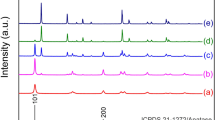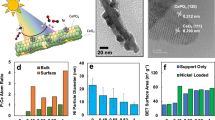Abstract
Using solar energy to decompose water and produce hydrogen for use in hydrogen energy systems has attracted much attention. Some semiconductors (such as TiO2 and SrTiO3) can decompose water to produce hydrogen and oxygen using the energy1 of light and the decomposition of water using powdered semiconductors has been reported2,3. One problem with powdered semiconductors is that when H2O decomposes into H2 and O2 in one cell an explosive gas is produced. Furthermore, although Schrauzer and Guth reported2 that traces of H2 and O2 were detected after the decomposition of water gas on TiO2, the reverse reaction will increase simultaneously as product is evolved. Hydrogen evolution stopped after a few hours. Hence the hydrogen or oxygen produced should be converted to more stable gaseous chemical species. The use of solid carbon is an interesting problem in relation to coal gasification and we have now examined the photocatalytic decomposition of water on TiO2 using solid carbon. We found that reactions (1) and (2) 
 occur producing hydrogen gas from water vapour and solid carbon when mixed powders of TiO2, RuO2 and active carbon exposed to water vapour at room temperature ∼80 °C are illuminated. The free energies are increased by 63 and 92 kJ mol−1 respectively, utilising light energy.
occur producing hydrogen gas from water vapour and solid carbon when mixed powders of TiO2, RuO2 and active carbon exposed to water vapour at room temperature ∼80 °C are illuminated. The free energies are increased by 63 and 92 kJ mol−1 respectively, utilising light energy.
This is a preview of subscription content, access via your institution
Access options
Subscribe to this journal
Receive 51 print issues and online access
$199.00 per year
only $3.90 per issue
Buy this article
- Purchase on Springer Link
- Instant access to full article PDF
Prices may be subject to local taxes which are calculated during checkout
Similar content being viewed by others
References
Maruska, H. P. & Ghosh, A. K. Solar Energy 20, 443 (1978).
Schrauzer, G. N. & Guth, T. D. J. Am. chem. Soc. 99, 7189 (1977).
Krasnovskii, A. A. & Brin, G. P. Dokl. Akad. Nauk SSSR 168, 1100 (1966).
Morita, M., Iwakura, C. & Tamura, H. Electrochim. Acta 23, 331 (1978).
Hemminger, J. C., Carr, R. & Somorjai, G. A. Chem. phys. Lett. 57, 100 (1978).
Inoue, T., Fujishima, A., Konishi, S. & Honda, K. Nature 277, 637 (1979).
Author information
Authors and Affiliations
Rights and permissions
About this article
Cite this article
Kawai, T., Sakata, T. Hydrogen evolution from water using solid carbon and light energy. Nature 282, 283–284 (1979). https://doi.org/10.1038/282283a0
Received:
Accepted:
Issue Date:
DOI: https://doi.org/10.1038/282283a0
This article is cited by
-
Hierarchical Assembly of SnO2/ZnO Nanostructures for Enhanced Photocatalytic Performance
Scientific Reports (2015)
-
Stacked ZnO nanorods synthesized by solution precipitation method and their photocatalytic activity study
Journal of Sol-Gel Science and Technology (2015)
-
Hydrogen Production Using Highly Active Titanium Oxide-based Photocatalysts
Topics in Catalysis (2008)
-
Reactions of water, dihydrogen, dinitrogen, dinitrogen oxide, methane over illuminated ultraclean graphite
Reaction Kinetics & Catalysis Letters (1993)
Comments
By submitting a comment you agree to abide by our Terms and Community Guidelines. If you find something abusive or that does not comply with our terms or guidelines please flag it as inappropriate.



